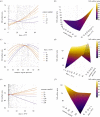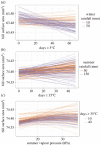Spatial variation in avian bill size is associated with temperature extremes in a major radiation of Australian passerines
- PMID: 38262606
- PMCID: PMC10805599
- DOI: 10.1098/rspb.2023.2480
Spatial variation in avian bill size is associated with temperature extremes in a major radiation of Australian passerines
Abstract
Morphology is integral to body temperature regulation. Recent advances in understanding of thermal physiology suggest a role of the avian bill in thermoregulation. To explore the adaptive significance of bill size for thermoregulation we characterized relationships between bill size and climate extremes. Most previous studies focused on climate means, ignoring frequencies of extremes, and do not reflect thermoregulatory costs experienced over shorter time scales. Using 79 species (9847 museum specimens), we explore how bill size variation is associated with temperature extremes in a large and diverse radiation of Australasian birds, Meliphagides, testing a series of predictions. Overall, across the continent, bill size variation was associated with both climate extremes and means and was most strongly associated with winter temperatures; associations at the level of climate zones differed from continent-wide associations and were complex, yet consistent with physiology and a thermoregulatory role for avian bills. Responses to high summer temperatures were nonlinear suggesting they may be difficult to detect in large-scale continental analyses using previous methodologies. We provide strong evidence that climate extremes have contributed to the evolution of bill morphology in relation to thermoregulation and show the importance of including extremes to understand fine-scale trait variation across space.
Keywords: Meliphagides; bill size; climate extremes; thermoregulation.
Conflict of interest statement
We declare we have no competing interests.
Figures



Similar articles
-
Australian birds track climate warming over decades via shifts in bill morphology.Commun Biol. 2025 Apr 18;8(1):633. doi: 10.1038/s42003-025-08042-7. Commun Biol. 2025. PMID: 40251339 Free PMC article.
-
The evolution of the avian bill as a thermoregulatory organ.Biol Rev Camb Philos Soc. 2017 Aug;92(3):1630-1656. doi: 10.1111/brv.12299. Epub 2016 Oct 7. Biol Rev Camb Philos Soc. 2017. PMID: 27714923 Review.
-
The influence of the California marine layer on bill size in a generalist songbird.Evolution. 2012 Dec;66(12):3825-35. doi: 10.1111/j.1558-5646.2012.01726.x. Epub 2012 Jul 27. Evolution. 2012. PMID: 23206140
-
Geographical variation in bill size across bird species provides evidence for Allen's rule.Am Nat. 2010 Aug;176(2):188-97. doi: 10.1086/653666. Am Nat. 2010. PMID: 20545560
-
Glucocorticoids in a warming world: Do they help birds to cope with high environmental temperatures?Horm Behav. 2022 Jun;142:105178. doi: 10.1016/j.yhbeh.2022.105178. Epub 2022 May 10. Horm Behav. 2022. PMID: 35561643 Review.
Cited by
-
Genetic and morphological shifts associated with climate change in a migratory bird.BMC Biol. 2025 Jan 7;23(1):3. doi: 10.1186/s12915-024-02107-5. BMC Biol. 2025. PMID: 39773181 Free PMC article.
-
Threat reduction must be coupled with targeted recovery programmes to conserve global bird diversity.Nat Ecol Evol. 2025 Aug;9(8):1499-1511. doi: 10.1038/s41559-025-02746-z. Epub 2025 Jun 24. Nat Ecol Evol. 2025. PMID: 40555799 Free PMC article.
-
Australian birds track climate warming over decades via shifts in bill morphology.Commun Biol. 2025 Apr 18;8(1):633. doi: 10.1038/s42003-025-08042-7. Commun Biol. 2025. PMID: 40251339 Free PMC article.
References
-
- Janse van Vuuren AK, Kemp LV, McKechnie AE. 2020. The beak and unfeathered skin as heat radiators in the southern ground-hornbill. J. Avian Biol. 51, 1-7. (10.1111/jav.02457) - DOI
MeSH terms
LinkOut - more resources
Full Text Sources
Other Literature Sources

